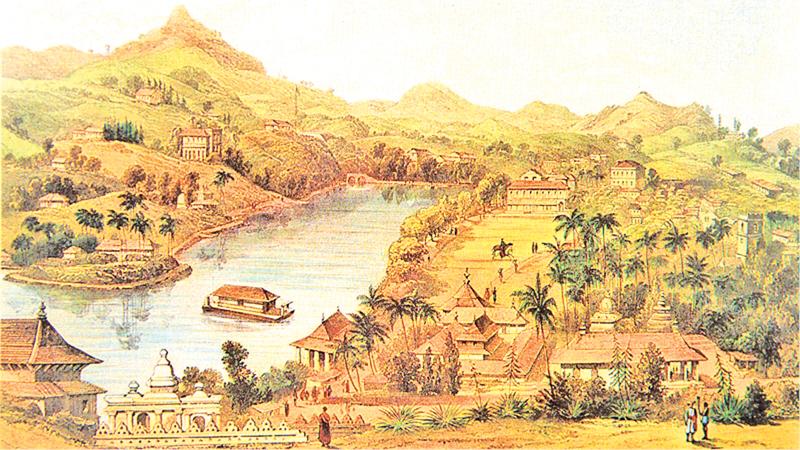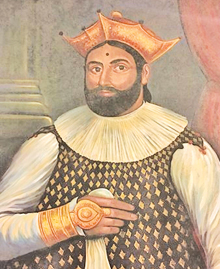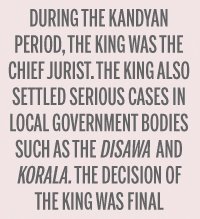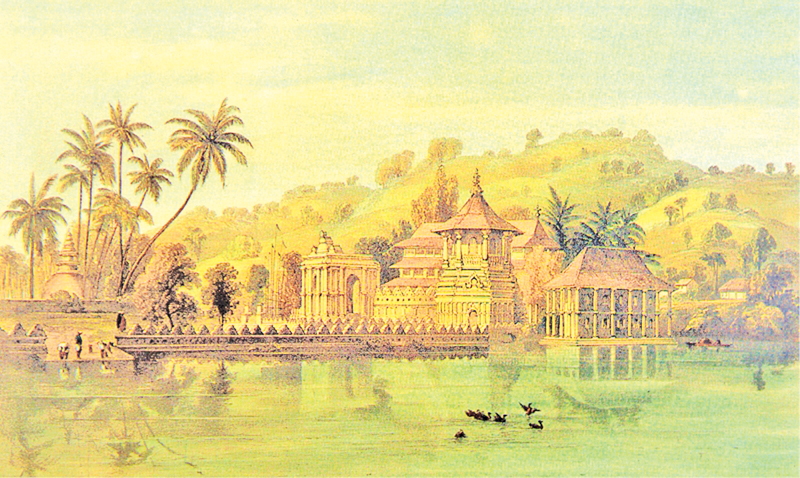
Dividing countries into regional administrative units for ease of administration can be seen in almost all countries of the world. Similarly, Sri Lanka is currently divided into various Local Government Units such as Provincial Councils, Pradeshiya Sabhas, Municipal Councils and Urban Councils.
The heads of such governing bodies, at present, do not have the power to enforce the civil and criminal law since law enforcement in all the administrative units in the country is done through the Police and a common court system.
However, an examination of the functioning of the judiciary during the Kandyan Kingdom, the last kingdom of Ceylon, reveals that in addition to the then-ruling King, the heads of locally active governing bodies also had more or less judicial powers (including imposing penalties). In addition, a special court called Sakki Balanda had been set up at that time.
How crimes were classified
 Sri Vikrama Rajasinha, the last king of Kandy |
During the period, crime was divided into two main categories. Crimes that threatened the security and sovereignty of the state were considered serious crimes. Among the other serious crimes were: murder, mutilation or beheading, conspiracy to assassinate a king, queen or princes, theft of the king's wealth or property, making counterfeit coins, destruction of religious statues and assault on Buddhist monks. Fights, petty thefts, and toddy brewing were among non-serious crimes.
Judicial powers
During the Kandyan period, the king was the chief jurist. The king also settled serious cases in local Government bodies such as the Disawa and Korala. The decision of the king was final. It was also the responsibility of the King to hear cases filed by citizens against officials of the local Government bodies below him.
There were several ways in which appeals were made to the king. One was that the victim brings it to the attention of the king through some local ruler or another official. The other was that the person was lying on the road facing the palace when the king was going out. Sometimes, people used to climb a tree near the king's palace to voice their grievances and come to the Temple of the Tooth Relic or any other royal or religious place.
When the appeal was brought to the attention of the king, the king used to begin hearing evidence from both parties. The Nilames were the ones who were hearing evidence under the king's directions. The king then consulted them and gave a verdict.
 The aforesaid judicial process was known as the Mahanaduwa or 'Royal Court' and was similar to the present Supreme Court. It consisted of Adikarams (a local ruler), Disawes, and Muhandirams. This court was held on several occasions in a building outside the royal palace or sometimes in the Magul Maduwa in Kandy.
The aforesaid judicial process was known as the Mahanaduwa or 'Royal Court' and was similar to the present Supreme Court. It consisted of Adikarams (a local ruler), Disawes, and Muhandirams. This court was held on several occasions in a building outside the royal palace or sometimes in the Magul Maduwa in Kandy.
Local rulers
At the time, the Adikarams had jurisdictions second only to the king and had the power to hear cases within the province that were coming under their control. They were empowered to deal with civil and criminal cases in the area. They prosecuted and convicted the perpetrators of burglary, assaults and other minor offenses.
Those who held the post of Disawe, which was a Government post at the time, had jurisdiction over the lands and people of their areas. The cases were heard in the Judiciary at their residence (Walawwa). Officers, known as Muladeni, were also stationed in front of Disawes when the cases were being taken up. In some cases, the cases were handed over to two or three chief Mohottalas or Koralas, who were hearing the cases at a place which was known as Atapattu Maduwa. The secretaries, Rate Mahattayas, Basnayake Nilames, and certain other officials also had civil and criminal judicial powers only over those under their control. Local rulers such as the Atapattus, Kodithuwakkus, Korales and Arachchis also had limited judiciary powers.
John Davy, an English officer who served in the country during the Kandyan period, mentions in his notes a special court which existed at that time. It is called Sakki Balanda. This can be identified as a special court of inquiry.
Davy likened the process to the work of a coroner in England. When it was found that a dead body was in a certain place, it was forbidden to touch the body until this special court conducted an inquiry into the matter. If it were a suicide, the court fined the villagers. If the person who committed suicide was not mentally fit, such a fine was not imposed.
Prisons
During the Kandyan period, the main prison was located in Kandy and was guarded by a group called the Rakawallo. Relatives provided food for the prisoners as the Government did not provide meals to them. When the relatives stopped providing food, they were allowed to go out into the streets and beg. Apart from the prison in Kandy, there were also prisons in Tellipehe, Dangomuwa, Kehelella, Bintenna, Laggala, Atanwala and Buttala. Many of these can be considered outdoor prisons. Robert Knox, a Kandyan prisoner for 19 years from 1660 to 1679, was also held in such prisons.

